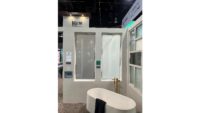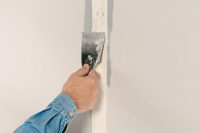You might think that a name like Fat Boy’s Pizza is all the branding a business would need for success, but founder and CEO Gabe Corchiani knows better. A strong brand goes beyond name recognition and creates a unique, identifiable experience. That’s why Fat Boy’s makes 30-inch pizzas and every location in the growing chain features the same distinctive, memorable interior design that Corchiani and his wife, Karen, created. Their unique combination of rustic, industrial and elegant materials starts at the floor and is topped off by a thermoformed ceiling.
Fat Boy’s, whose motto is “Size Matters,” was founded in 2019 and had expanded to three locations in the New Orleans area by the end of that year. The growing chain made a name for itself with the “2-Foot Challenge”: eat a wedge-shaped slice 24 inches long and 16 inches wide in just seven minutes and win a $20 gift card and a T-shirt reading, “I Conquered the 2-Foot Challenge.” It became so well known that the restaurant hosted a special challenge with some of the world’s top competitive eaters, featured on ESPN. Championship eater Joey Chestnut was victorious, scarfing down 2-foot slices—8.66 square feet of pizza—in 10 minutes.
Find the Right Design
When it came to designing the restaurants, the Corchiani’s knew what they were looking for. “We wanted something original, a little different,” Gabe says. “On the walls, we do old corrugated tin from the baseboard up to chair rail. From the chair rail up to ceiling, old dirty top pine board that we find generally in old wood mills and places. Where we have bars, we have a space above the bar where we put TVs and we use old weathered bead board up there. All of our bar tops are thick old pine with a shiny, hard coat of polyurethane. Our back bar area and where our ovens are is done in white subway tile.”
For the ceiling, Gabe wanted something he’d seen at high-end bars in New York, the look of early-20th-century stamped metal ceilings. He selected a pattern of thermoformed tiles in a metallic tin finish. The tiles are non-absorbent and easily washable, so they are approved for use in food preparation areas. They are also GreenGuard Gold-certified to protect indoor air quality and made of 98-percent recycled materials. However, what attracted Gabe most was the appearance. “It gives the characteristic, the feeling that it’s real tin,” he says. “It looks real expensive and rich-looking and classic.”
In the Oven
This engaging mixture of materials became Fat Boy’s standard appearance, their experiential brand. “You have that old pine on the walls and then you have that corrugated tin, some of it has paint on it, some of it is rusted and the ceiling is just so clean,” Gabe explains. “The ceilings pop. It’s not a clash, but it really accents it well, it pops more. It actually makes it look more classy and clean.”
Fat Boy’s has survived and thrived through the COVID-19 pandemic, which caused the demise of so many restaurant businesses, and has continued to expand to new locations, with six in the New Orleans area and one each in Baton Rouge, La.; Hattiesburg, Miss.; and Richmond, Texas. Fat Boy’s is also offering its success to franchisees.





Report Abusive Comment